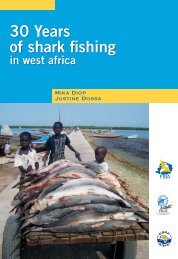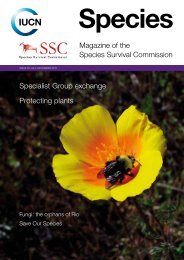Kyne & Simpfendorfer.. - Shark Specialist Group
Kyne & Simpfendorfer.. - Shark Specialist Group
Kyne & Simpfendorfer.. - Shark Specialist Group
Create successful ePaper yourself
Turn your PDF publications into a flip-book with our unique Google optimized e-Paper software.
Table 2.4. Age and growth of centrophorid sharks. von Bertalanffy growth model (VBGM)<br />
parameters: L ∞ (mm TL), k (year -1 ), t 0 (years); t max oldest fish (years), A mat age at maturity<br />
(years). Band count method: Int DS, internal dorsal spine band count; Ext DS, external dorsal<br />
spine band count; RadioM, radiometric ageing.<br />
Species Location Method<br />
VBGM parameters<br />
L ∞ k t 0<br />
t max A mat Reference<br />
Centrophorus<br />
acus<br />
Suruga Bay, Japan, NW<br />
Pacific<br />
Int DS ♀ 1262<br />
♂ 1172<br />
0.155<br />
0.173<br />
-0.485<br />
-1.403<br />
18<br />
17<br />
--<br />
10<br />
Tanaka (1990)<br />
Centrophorus<br />
granulosus<br />
Western Mediterranean Int DS ♀ 1094<br />
♂ 917<br />
0.096<br />
0.107<br />
-5.48<br />
-9.78<br />
39<br />
25<br />
16.5<br />
8.5<br />
Guallart (1998)<br />
Centrophorus<br />
squamosus<br />
Rockall Trough and<br />
Porcupine Bank, NE<br />
Atlantic<br />
Int DS ♀ --<br />
♂ --<br />
--<br />
--<br />
--<br />
--<br />
70<br />
71<br />
35<br />
30<br />
Clarke et al. (2002a)<br />
Centrophorus<br />
cf. uyato<br />
Australia RadioM ♀ + ♂ -- -- 46* -- Fenton (2001)<br />
Deania calcea<br />
Rockall Trough and<br />
Porcupine Bank, NE<br />
Atlantic<br />
Int DS ♀ 1193<br />
♂ 935<br />
0.077<br />
0.135<br />
-0.933<br />
-0.165<br />
35<br />
32<br />
25<br />
--<br />
Clarke et al. (2002b)<br />
SE Australia Ext DS ♀ 1225<br />
♂ --<br />
0.051<br />
--<br />
-5.11<br />
--<br />
37<br />
33<br />
21.5<br />
13.5<br />
Irvine (2004)<br />
*No mature specimens were aged.<br />
Family Etmopteridae. Lanternsharks.<br />
The lanternsharks are the most diverse family of squaloid sharks, with 47 species, all of which<br />
inhabit deepwater. Endemism is high in this family; many have restricted ranges, while others<br />
are more wide-ranging and global in their distribution. The vast majority of species are<br />
poorly-known, particularly the more localised species. For example, the smalleye lanternshark<br />
Etmopterus litvinovi has only been recorded from two isolated ridges in the Southeast Pacific<br />
while the rare cylindrical lanternshark E. carteri has only ever been located from a small area<br />
and narrow depth range on the upper slope off the Caribbean coast of Colombia. A group of 6<br />
Australian and New Caledonian Etmopterus spp are known only from their original<br />
description (Last, Burgess and Séret 2002), a situation not uncommon amongst the deepwater<br />
squaloids. The biology of these species and many other etmopterids is virtually unknown.<br />
Reproductive and age and growth parameters for etmopterid sharks are summarized in Tables<br />
2.5 and 2.6, respectively.<br />
While there is biological information for two species of Centroscyllium and several<br />
Etmopterus, primarily from studies conducted in the NE Atlantic and southern Australia, the<br />
sole members of the three other etmopterid genera (Aculeola, Miroscyllium and<br />
Trigonognathus) are very poorly-known. Acuña et al. (2003) reports an average litter size of<br />
10 in the hooktooth dogfish Aculeola nigra from off Chile and Yano et al. (2003) noted that<br />
litter size in the viper dogfish Trigonognathus kabeyai from southern Japan is likely to be
















